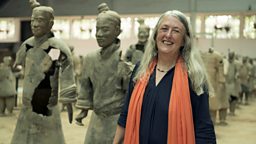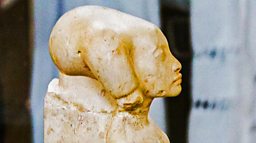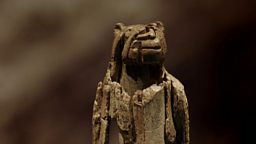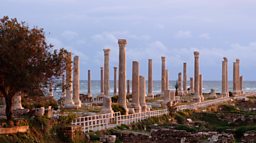Nine fascinating facts we learned from The Civilisations Podcast
29 March 2018
With its high-definition shots of beautiful art, Civilisations is a feast for the eyes. But the accompanying audio from The Civilisations Podcast is a treat for your ears. Viv Jones has been exploring the series' themes – and it's taken her off on some quirky tangents.
There's enough landscape art in US prisons to fill a whole book

Alyse Emdur's book contains over 100 images of prisoners posing in front of landscape paintings.
Her interest was sparked after she found a Polaroid of her family in front of a painted beach scene in the visiting room of the prison where her brother was an inmate.
In episode three she tells Viv: "I was startled by something about it. This painting behind us represented freedom, the exact opposite of what my brother was living."
During the course of her research, Alyse discovered that the backdrops are often painted by talented prisoners before being utilised as a backdrop for portraiture sessions.
Ultimately she spent six years collecting photographs from prisoners, as well as taking her own images, before curating them in her book, Prison Landscapes.
More on prison art
-
![]()
The Civilisations Podcast: Episode three
Alyse Emdur's book explores landscape paintings in prison.
-
![]()
The firms offering hope to Mexican prisoners
Prison tattooists are now imprinting designs on to bags and clothes.
Mary Beard didn't really want to be a TV presenter

I was very reluctant because I know telly takes forever, it's not just speaking a few words to camera and disappearingMary Beard
In episode two Viv caught up with Mary Beard. The classicist admits she wasn't overly enthusiastic about the prospect of becoming a TV presenter.
She reveals: "I didn't do any telly until I was 50. I didn't particularly want to do it, really. I was sort of chatted up by Janice Hadlow, who was then the controller of BBC Two.
"I was very reluctant because I know telly takes forever. You have to sit around the whole time, it's not just going and speaking a few words to camera and disappearing. It's hours and hours, really boring stuff!
"She said, 'I know you've said publicly that if you look at history documentaries that it's wrinkled old men, you don't ever get middle-aged female historians doing telly. Now, my dear, I'm giving you the chance to do it, you're jolly well going to do it otherwise that's really bad faith, and stop complaining'."
More from Mary Beard
-
![]()
The Civilisations Podcast: Episode two
Mary Beard talks about the making of Civilisations.
-
![]()
Why a new understanding of 'civilisation' matters
Mary Beard discusses the nature of civilisation. And the significance of ancient Egyptian cake.
-
![]()
Civilisations: The Eye of Faith
Mary Beard broaches the controversial, sometimes dangerous, topic of religion and art.
Brave people risk their lives to protect art in war zones

This is my museum, this is our museum, this should not happen to itMonica Hanna
During the 2013 coup in Egypt, archaeologist Monica Hanna and her friend Safa drove for hours through fighting between rebels and the security forces. Their goal was the Mallawi City Museum in central Egypt, which had been attacked by looters.
In episode one, Hanna tells Viv her story: "No one was really giving attention to the museums... This is my museum, this is our museum, this should not happen to it. We should just not leave it up to the government to react because apparently they're afraid or reluctant to do anything about it... I took the situation in hand."
When they reached the museum, which sits on the banks of the Nile a few hours south of Cairo, they found that many artefacts had been stolen and destroyed.
Monica and Hanna found themselves face-to-face with protesters seeking to vent their frustration. They told her: "The government is killing our people and this is our chance to take revenge from the government."
Protecting art during conflict
-
![]()
The Civilisations Podcast: Episode one
Monica Hanna tells how she rescued Egyptian mummies under fire.
-
![]()
Would you die for art?
The people willing to risk their lives for art.
-
![]()
A cultural property protection unit?
Art dealer and British army reservist Lt Colonel Tim Purbrick discusses how such a unit could work.
David Attenborough commissioned Civilisation to sell the idea of colour telly

I ran it for 13 episodes because we had to convince people who hadn't yet bought their colour television setsDavid Attenborough
Before he was the naturalist national treasure we know and love today, David Attenborough was a senior BBC executive. And in the late 1960s he had a problem – people weren't that enthusiastic about the new technology, colour TV.
In episode two of the podcast, we hear from the man himself about how the 1969 series Civilisation came into being partly because of this issue.
He says: "I thought a very simple idea would be to get all the loveliest pictures in colour, put them in chronological order and there you would have a series.
"There was one person you would have to consult in those days, Kenneth Clark. We invited him to lunch and started talking about it. It was him that changed the simple functional idea into something of a masterpiece, along with Peter Montagnon and Michael Gill.
"They weren't just about pictures; they're about philosophy, science, Rousseau, Goethe, Shakespeare, Mozart, Beethoven. I ran it for 13 episodes because we had to convince people who hadn't yet bought their colour television sets."
More on Civilisation (1969)
-
![]()
iPlayer box set: Civilisation
Watch Kenneth Clark's classic series tracing the history of Western art and philosophy.
-
![]()
The Civilisations Podcast: Episode two
David Attenborough talks about his role in commissioning Civilisation in the 1960s.
-
![]()
Civilisations: The Inside Story
Mary Beard and Simon Schama on the differences between their series Civilisations and the 1969 Civilisation.
Even in the Ice Age there was art

What’s the Sistine Chapel, is that art or is that religious? You can’t separate one from the other!Jill Cook
In episode one Viv went to the British Museum – and was thrilled to be escorted through a secret door disguised as a bookcase. On the other side she met Jill Cook, a specialist in the archaeology of human evolution.
Jill emphatically believes that the creativity of the earliest humans should be called art: "I called my book Ice Age Art so I'm a firm believer!"
She tells Viv: "I think this idea that the art of deep, deep history should not be called art comes from ideas of the mid-20th Century which tried to say, 'well these are people who had a different lifestyle from us, they lived by hunting and gathering, their economy is different. We don’t know exactly what they believed in, so we shouldn’t call this art'."
Therefore in an age where surviving was a probably a full-time occupation, there must have been a significance to objects beyond their aesthetic appeal – they must have had a spiritual or religious purpose.
That doesn't mean they're not art in Jill's eyes: "What’s the Sistine Chapel, is that art or is that religious? You can’t separate one from the other!"
Ice Age art
-
![]()
The Civilisations Podcast: Episode one
Archaeologist Jill Cook on the earliest human art.
-
![]()
When art is as important as survival
Why did a community set an artist free to create Lion Man over 40,000 years ago?
-
![]()
Ice Age Art exhibition
The British Museum show which brought together sculptures, drawings and portraits from between 10,000 and 40,000 years ago
Ansel Adams played the piano with his bum

If he wanted a big majestic chord, he'd turn around and play it with his behindKenneth Brower on Ansel Adams' piano playing
Before he fell in love with photography, Ansel Adams aspired to be a concert pianist. While he would instead find acclaim as a photographer, he didn't give up on playing the piano.
In episode three Kenneth Brower, an environmental writer who knew Adams, describes how Adams still loved to play for people.
Brower says: "He would play around on the piano, he would play certain notes with an orange. He would do this in the middle of a serious piece, it would go nutty. If he wanted a big majestic chord, he'd turn around and play it with his behind.
"He was just full of fun in that way. At the end of the day, when he'd finished in his dark room, he liked to unwind. All the sort of bohemians, the pre-hippies, would come by."
More on Ansel Adams
-
![]()
The Civilisations Podcast: Episode three
American photographers with very different subjects: Alyse Emdur and Ansel Adams.
-
![]()
Amazing Ansel Adams photos
The celebrated landscape photographer also took images of interned Japanese-Americans during WW2.
There was a plan to build a tiny restaurant on a Battersea cooling tower

They had a plan to install, at the top of one of the chimneys, a single table restaurantBrian Dillon
In episode four Viv meets up with writer and critic Brian Dillon to explore our collective fascination with ruins.
He tells her about one wacky plan for London landmark Battersea Power Station, which he says has been "languishing since the early 1980s as a kind of modern industrial ruin".
He adds: "I first visited about 10 years ago and the developers who were working on the site told me they had a plan to install, at the top of one of the chimneys, a single table restaurant.
"So one would ascend through the chimney and maybe two, three or four people could have dinner looking out over the city, at the pinnacle of this post-industrial ruin. That seems to me a really fantastic emblem of how cities succeed and sometimes really fail to remake their ruins."
The collapse of civilisations
-
![]()
The Civilisations Podcast: Episode four
Brian Dillon discusses the attraction of ruins.
-
![]()
How Western civilisation could collapse
Some possible precipitating factors are already in place, says Rachel Nuwer.
The Nazis wanted to design buildings that would make attractive ruins

Hitler liked to say that the purpose of his building was to transmit his time and its spirit to posterityNazi architect Albert Speer
Brian Dillon also tells Viv that the Nazis had a surprising attitude toward ruins. He says: "Hitler's architect Albert Speer had an idea of what he called ruin value. This had come into his mind because he had seen buildings bombed and thought of them in terms of classical ruins. They immediately reminded him of the ruins of Greece and Rome.
"Speer comes up with an idea in his projected rebuilding of Germany, and especially of Berlin, that these buildings should be built so that they would make attractive ruins in thousands of years to come."
While other Nazi leaders were worried about suggesting to Hitler that the Nazi era would end, the Führer was taken by the idea that their architecture would sit in the landscape exuding faded grandeur for all time.
Speer wrote about the war after he was released from 20 years in prison: "Hitler liked to say that the purpose of his building was to transmit his time and its spirit to posterity."
Dillon adds: "It's part of the Nazi's conservative aesthetics, part of their return to the classical as a very simple, and in many respects a simple-minded vision, of what the architecture of the future should be."
More on ruins
-
![]()
The Civilisations Podcast: Episode four
Brian Dillon discusses the attraction of ruins.
-
![]()
From Pompeii to Detroit: Why ruins fascinate
Decaying structures, from crumbling castles to industrial ghost towns, have long fascinated us.
-
![]()
The timeless allure of ruins
Writers of the ancient world spoke of the wrecks of earlier societies with fear and longing.
Caravaggio viciously attacked a woman – then he became victim to the same crime

He acted like a devil, he painted like an angelSimon Schama
In Civilisations: The Triumph of Art, Simon Schama sums up the wild life of one the world's greatest ever painters: "Hair-trigger violent, short-fuse foul-mouthed, unwashed hoodlum; constantly in trouble with the cops, in and out of jail. But if he acted like a devil, he painted like an angel..."
In 1609 he was disfigured in an attack known as ‘sfregio’ – an Italian word which can mean either a gash or an insult. The purpose of this was to leave the victim permanently scarred and visibly dishonoured.
Caravaggio himself was no stranger to this act – seven years before he had attacked a courtesan in the same way because she had refused to sleep with him.
In Caravaggio's case, so numerous were his enemies it was hard to know who was behind his assault. In episode five Viv seeks out experts and delves into the BBC archive to reveal the truth about the wild life of the artistic genius.
More on Caravaggio
-
![]()
The Civilisations Podcast: Episode five
Viv finds ous more about the life of Caravaggio
-
![]()
Civilisations: The triumph of art
Simon Schama explores how the likes of Caravaggio, Velasquez and Rembrandt shook off decorum.
-
![]()
Why Caravaggio casts a long shadow
He lived a scandalous life but was the most celebrated artist of his day.
Subscribe to The Civilisations Podcast
There are already five amazing episodes of The Civilisations Podcast available for you to enjoy, with another five to look forward to. Subscribe on the podcast platform of your choice to get a new episode every Thursday at 10pm for the next five weeks.
More from Civilisations
-
![]()
Hue knew? Five surprising facts about colour
Colour is a complicated and, at times, controversial topic.
-
![]()
Explore masterpieces of European painting
Five of the most significant paintings in the history of Western art.
-
![]()
Order a free poster from the Open University
OpenLearn, the OU’s home of free learning, helps you explore the art of different civilisations of the world.
-
![]()
Digital innovations
Explore artefacts using the augmented Reality (AR) app and 360 degrees videos, plus storytelling collaborations with UK museums and galleries.
-
![]()
The Czech and the Chieftains
How the Māori community turned the tables on colonial art.
-
![]()
9 fascinating facts from The Civilisations Podcast
Viv Jones' audio companion to the BBC Two series is taking us on some intriguing tangents.
-
![]()
The Inside Story
Mary Beard and Simon Schama reveal the inside story of writing and presenting the BBC Two series Civilisations.
-
![]()
Civilisations: Box set
Watch all nine episodes of the series on BBC iPlayer.





























